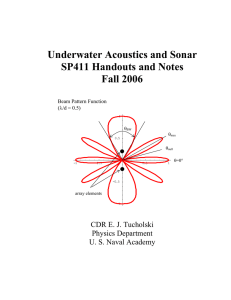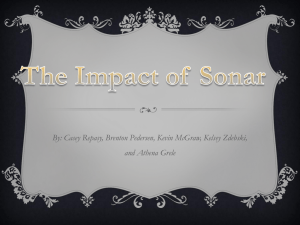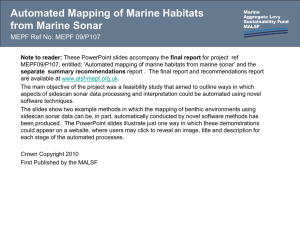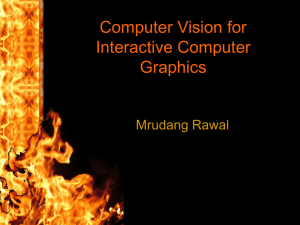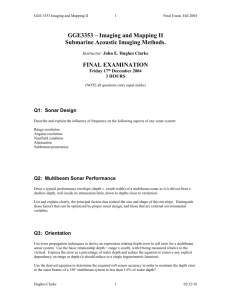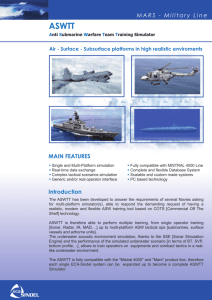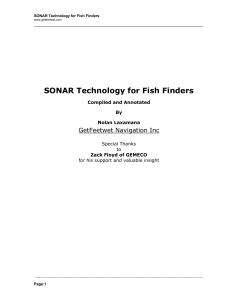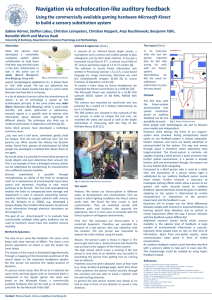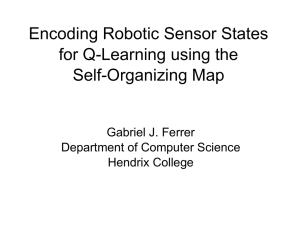Predictive tool for ammunition detection
advertisement
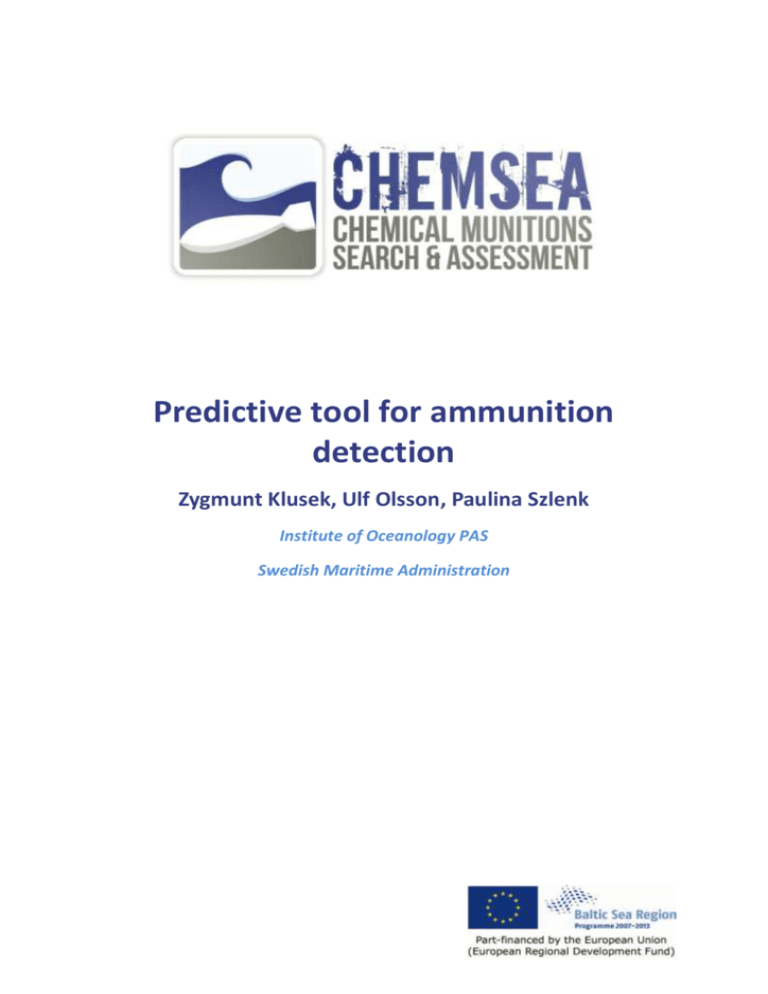
Predictive tool for ammunition detection Zygmunt Klusek, Ulf Olsson, Paulina Szlenk Institute of Oceanology PAS Swedish Maritime Administration Predictive tool for Ammunition detection 30.04.2014 2 Introduction In the last decades, various systems and algorithms according to authors with high recognition rates had been introduced into sea-mine detection and recognition. The general problems of these systems are costs related to an effort receiving clear included many pixels images (ship time, modern setup) and computational costs in data preparation and transformation to other spaces. A target recognition rate significantly increases if there are hundreds of sonar picture elements (pixel) of a target with accompanying shadow, what require high ping rates and slow speed of a ship - the last decreasing the size area under investigations. Studies using published in the literature different methods regarding detection and classification of chemical munition were carried out. The state-of-the-art algorithms proposed prevailing in the last decade in the field of mine detection and classification were used in programs. Moreover, programs for data assimilation from 12 kHz echosounder, and further processing aimed at the bottom sediment recognition were performed. Ammunition detection methods conducted by CHEMSEA project The target recognition algorithms were applied to the SSS images provided by the SMA and IO PAS teams of hydroacoustician where preliminary segmentation was performed by operators. Program codes were written in MATLAB language (tested in the MATLAB 2011b version). Ideas were taken from Grasso and Spina, 2006 using a non-parametric detector which does not assume any information on the statics of the sea bottom and the target signals. The detector extracts the speckles and the shadow areas from the input (however transformed) image by estimating adaptively the minimum and maximum levels of the seafloor background signal envelope through a series of morphological non-linear filters. Author contributions is using the same algorithm for reversed gray scale images and use extracted shadows parameters for future classification, as presented in Fig.1. After non-linear filtering parameters of highlights and shadow were calculated and send to do data base for further analysis. At the next stage the Neural Network classification algorithm, K-means algorithm, Fuzzy c-means clustering, two-layer feeding forward network, with tansigmoid transfer function in the hidden layer and a linear transfer function in the output layer were tested. Success rate high (>75%), only in the case of the sphere-shape- sea mines, subclass of man made munition class. No preferences for whichever method was found. As in others fields of image recognition techniques the gray-level co-occurrence matrix was tested. The results that carry information about distribution of intensities and the relative position of pixels with respect to each other in that texture (image). The method seems to be a promising. In our case study, we only used and computed the following five main Haralick’s coefficients on GLCM for texture analysis and the classification as Contrast, Entropy, Energy, Correlation, Homogeneity, std, etc. Two among them recommended themselves as particularly useful - contrast and energy. 3 Predictive tool for Ammunition detection 30.04.2014 Symbolic pattern analysis of sidescan sonar images proposed for underwater target detection (Rao, et al., 2009) is helpful for operator detection only in undisturbed by fishery activity bottom areas. Pixel Number TargetName CB0007,1. pit TargetName CB0007,1. pit 5 10 10 20 15 30 20 40 25 50 30 60 35 70 10 20 Pixel Number 30 20 40 Pixel Number 60 Fig. 1. Example of a raw target image (on the left) and after reconstruction 4. Sediment recognition and classification was performed with : in the case of sea bed geomorphology with the side scan sonar and to map the acoustic properties of sediments single beam echosounder at 12 kHz. . TargetName CB0007,1. pit 10 10 20 20 Pixel Number Pixel Number TargetName CB0007,1. pit 30 40 30 40 50 50 60 60 70 70 10 20 30 40 Pixel Number 50 60 10 20 4 30 40 Pixel Number 50 60 Fig. 2. Contours of speckles (on the left) and shadows (on the right) for the target from Fig.1.. Feature High- Shalight dow Centroid 2.85 Area [m^2] 3.16 Perimeter [m] 1 .62 MajorAxisLength 0.78 MinorAxisLength 1.23 Orientation [deg] 35.7 MaxIntensity 18.48 MinIntensity 30.28 MeanIntensity 31.05 16.50 35.79 4.92 3.77 -0.41 32.38 29.06 30.21 29.74 Table 1. Extracted morphological parameters for a target and its shadow. Tests on convolution of images gives perfectly good results but only for very similar targets on the same type of the bottom. 5 Predictive tool for Ammunition detection 30.04.2014 Among unsuccessfully tested algorithms was the contourlet detector method aimed at improvements of the edge detection of highlights (Wilbur and McDonald, 2009), . Summary On the basis of literature and tests performed on the collected sonar images of objects lying on the sea bottom, we could conclude that automatic detection and classification methods for SSS images are not successful in present. Developed automatic classifying algorithms do no work well for noisy sonar images received from various types of sediments. We agree with Dobeck (2001) that the most prospective approach in targets detection and classification is fusion of multiple detection/classification algorithms reducing false alarm rate, and preserving a high probability of detection and classification. It looks promising that the use of the Haralick’s texture features and morphology features, extracted from multispectral images are a good way to improve classification. In their review paper Geethalakshmi et al. presented success rate in mines detection with NN algorithms, most of them above 90%, some reaching incredible 99%. However, the cited experiments were performed in ideal condition frequently with freshly deployed, on hard bottom known targets, with great effort to obtain high quality images. The reasons for low success rate both computer aided methods and by operators are: • small number of pixels/target - with typical resolution 15X15 cm (in the modern mine hunting SAS equipment used resolution is 4X4 cm); • 60 years after deploying – targets are eroded or partly covered by sediments; • in some part of the area crossing trawling scars give false echoes; • in north-west area numerous stones or boulders gives false classification. References 1. Dobeck, G.J. , Algorithm fusion for automated sea mine detection and classification, in OCEANS, 2001. MTS/IEEE Conference and Exhibition, vol.1. pp. 130 - 134 vol.1 2. Wilbur JoE., R. J. McDonald, Contourlet Detection and Feature Extraction for Automatic Target Recognition, Proceedings of the 2009 IEEE International Conference on Systems, Man, and Cybernetics San Antonio, TX, USA - October 2009 3. Çelebi A. T. , S. Ertürk, (2010) Target Detection in Sonar Images using Empirical Mode Decomposition and Morphology, in Signal Processing and Communications Applications Conference (SIU), 2010 IEEE 18th, 760 - 763 4. Geethalakshmi, S. N. ,P. Subashini, S. Ramya, A Study on Detection and Classification of Underwater Mines Using Neural Networks, International Journal of Soft Computing and Engineering (IJSCE), ISSN: 2231-2307, ISSN: 2231-2307, Volume-1, Issue-5, November 2011 6 5. Rao C., K. Mukherjee, S, Gupta, A. Ray, S. Phoha, Underwater Mine Detection using symbolic Pattern Analysis of Sidescan Sonar Images, 2009 American Control Conference Hyatt Regency Riverfront, St. Louis, MO, USA June 10-12, 2009 6. Grasso R., F. Spina, Small bottom object density analysis from side scan sonar data by a mathematical morphology detector. The 9th International Conference on Information Fusion, 2006 7. Reed S., Y. Petillot, J. Bell, An Automatic Approach to the Detection and Extraction of Mine Features in Sidescan Sonar, IEEE JOURNAL OF OCEANIC ENGINEERING, vol. 28, No. 1, 2003 8. Chew A. L. , P. B. Tong, Ch. S. Chia Automatic Detection and Classification of Manmade Targets in Side Scan Sonar Images, Underwater Technology and Workshop on Scientific Use of Submarine Cables and Related Technologies, Tokyo,2007., pp. 126 132 7 Predictive tool for Ammunition detection 30.04.2014 8

